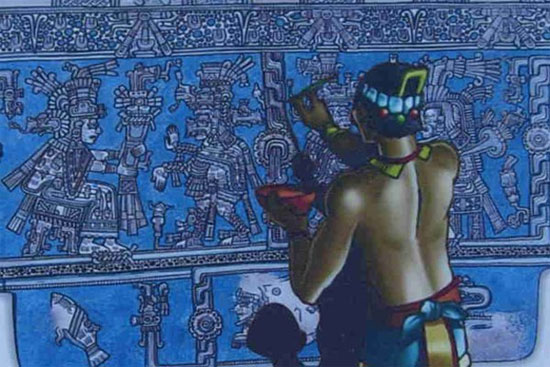See how the Mayan color is painted
Ancient Mayans decorated the walls of palaces, temples, handwritten manuscripts, painted ceramics and painted dead bodies before burying the sacred wells with a color blue paint. Very fresh and extremely durable.
It has long been known that the ancient Mayan blue color consisted of two main ingredients, a vegetable pigment, an indigo product (called indigo, taken from indigopher indigo (based on chemical formula). of it, today people synthesized by artificially dyeing jeans) and a mineral called paligorskite , contained in a local clay.

However, the Mayans have made this type of paint extremely durable over the years, which is still a mystery.
Antonio Domenech of the University of Valencia (Spain) and colleagues announced the discovery of dehidroindigo in paint stains. Additional colors seem to be formed by oxidation of indigo under the effect of temperature during the paint process.
"Indigo is green but dehidroindigo is yellow, so the presence of two colors in different proportions can get a lot of colors from dark blue to light blue" - Mr. Domenech said - 'Very good Mayan people already know how to adjust the flame temperature by reducing or adding firewood when cooking paint to create color fastness'.
In 2008 US researchers claimed that the secret ingredient was copal resin, often used as an aromatic substance to burn (similar to incense) in divine worship, creating a sanctuary atmosphere. This conclusion is based on the study of plastic containers (incinerators or incense sticks) that show traces of paint with paint.
However, Domenech and his colleagues at Valencia University (Spain) disagree with this conclusion. In his opinion, their sacrifices were created from before being used to burn bass.
Currently, Spanish scientists are studying the creation of chemical bonds between organic and inorganic substances (indigo and clay) to form a unified mass. These special links between the two substances are assumed to be the key to the extraordinary durability of the Mayan paint.
This study was published in the journal Microporous Materials (Microporous Materials).
- Why are all old villas painted yellow?
- Detect tremors about Pacal the Great Mayan
- Paintings change color like chameleon
- Why do aircraft often paint white?
- Guatemala discovered more than 2,700 years old Mayan ruins
- The Maya believed in the sun, heaven
- Mexico discovered 16th-century Mayan tombs
- Found ancient Mayan city in Mexican forest
- Discover the secret behind the Mayan's
- Paint cows like zebras to chase buffalo flies
- Mysterious beam of light on top of the Mayan pyramid
- The 1,000-year-old giant sacred hole lies under the Mayan temple
 'Fine laughs' - Scary and painful torture in ancient times
'Fine laughs' - Scary and painful torture in ancient times The sequence of numbers 142857 of the Egyptian pyramids is known as the strangest number in the world - Why?
The sequence of numbers 142857 of the Egyptian pyramids is known as the strangest number in the world - Why? History of the iron
History of the iron What is alum?
What is alum?